Georgios Kaissis
Technical University of Munich, Imperial College London
Unifying Re-Identification, Attribute Inference, and Data Reconstruction Risks in Differential Privacy
Jul 09, 2025Abstract:Differentially private (DP) mechanisms are difficult to interpret and calibrate because existing methods for mapping standard privacy parameters to concrete privacy risks -- re-identification, attribute inference, and data reconstruction -- are both overly pessimistic and inconsistent. In this work, we use the hypothesis-testing interpretation of DP ($f$-DP), and determine that bounds on attack success can take the same unified form across re-identification, attribute inference, and data reconstruction risks. Our unified bounds are (1) consistent across a multitude of attack settings, and (2) tunable, enabling practitioners to evaluate risk with respect to arbitrary (including worst-case) levels of baseline risk. Empirically, our results are tighter than prior methods using $\varepsilon$-DP, R\'enyi DP, and concentrated DP. As a result, calibrating noise using our bounds can reduce the required noise by 20% at the same risk level, which yields, e.g., more than 15pp accuracy increase in a text classification task. Overall, this unifying perspective provides a principled framework for interpreting and calibrating the degree of protection in DP against specific levels of re-identification, attribute inference, or data reconstruction risk.
Redirection for Erasing Memory (REM): Towards a universal unlearning method for corrupted data
May 23, 2025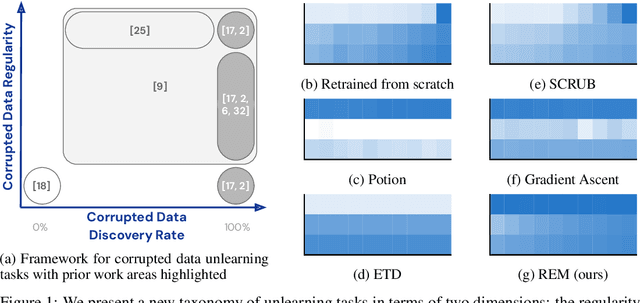
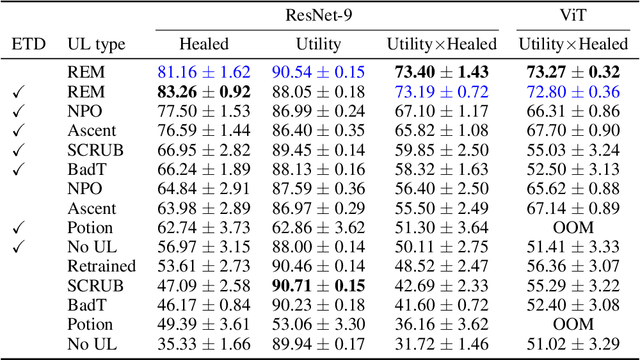


Abstract:Machine unlearning is studied for a multitude of tasks, but specialization of unlearning methods to particular tasks has made their systematic comparison challenging. To address this issue, we propose a conceptual space to characterize diverse corrupted data unlearning tasks in vision classifiers. This space is described by two dimensions, the discovery rate (the fraction of the corrupted data that are known at unlearning time) and the statistical regularity of the corrupted data (from random exemplars to shared concepts). Methods proposed previously have been targeted at portions of this space and-we show-fail predictably outside these regions. We propose a novel method, Redirection for Erasing Memory (REM), whose key feature is that corrupted data are redirected to dedicated neurons introduced at unlearning time and then discarded or deactivated to suppress the influence of corrupted data. REM performs strongly across the space of tasks, in contrast to prior SOTA methods that fail outside the regions for which they were designed.
Laplace Sample Information: Data Informativeness Through a Bayesian Lens
May 21, 2025



Abstract:Accurately estimating the informativeness of individual samples in a dataset is an important objective in deep learning, as it can guide sample selection, which can improve model efficiency and accuracy by removing redundant or potentially harmful samples. We propose Laplace Sample Information (LSI) measure of sample informativeness grounded in information theory widely applicable across model architectures and learning settings. LSI leverages a Bayesian approximation to the weight posterior and the KL divergence to measure the change in the parameter distribution induced by a sample of interest from the dataset. We experimentally show that LSI is effective in ordering the data with respect to typicality, detecting mislabeled samples, measuring class-wise informativeness, and assessing dataset difficulty. We demonstrate these capabilities of LSI on image and text data in supervised and unsupervised settings. Moreover, we show that LSI can be computed efficiently through probes and transfers well to the training of large models.
$(\varepsilon, δ)$ Considered Harmful: Best Practices for Reporting Differential Privacy Guarantees
Mar 13, 2025Abstract:Current practices for reporting the level of differential privacy (DP) guarantees for machine learning (ML) algorithms provide an incomplete and potentially misleading picture of the guarantees and make it difficult to compare privacy levels across different settings. We argue for using Gaussian differential privacy (GDP) as the primary means of communicating DP guarantees in ML, with the full privacy profile as a secondary option in case GDP is too inaccurate. Unlike other widely used alternatives, GDP has only one parameter, which ensures easy comparability of guarantees, and it can accurately capture the full privacy profile of many important ML applications. To support our claims, we investigate the privacy profiles of state-of-the-art DP large-scale image classification, and the TopDown algorithm for the U.S. Decennial Census, observing that GDP fits the profiles remarkably well in all three cases. Although GDP is ideal for reporting the final guarantees, other formalisms (e.g., privacy loss random variables) are needed for accurate privacy accounting. We show that such intermediate representations can be efficiently converted to GDP with minimal loss in tightness.
Improved Localized Machine Unlearning Through the Lens of Memorization
Dec 03, 2024
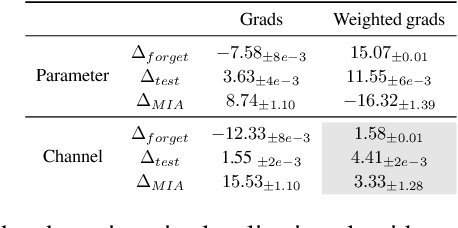

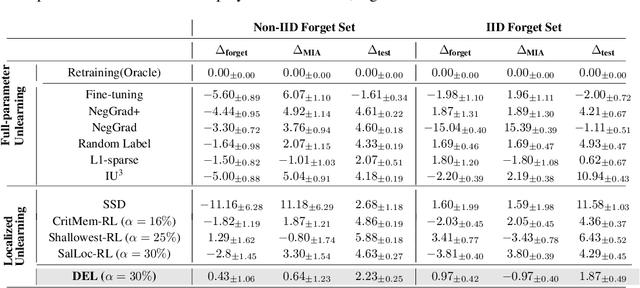
Abstract:Machine unlearning refers to removing the influence of a specified subset of training data from a machine learning model, efficiently, after it has already been trained. This is important for key applications, including making the model more accurate by removing outdated, mislabeled, or poisoned data. In this work, we study localized unlearning, where the unlearning algorithm operates on a (small) identified subset of parameters. Drawing inspiration from the memorization literature, we propose an improved localization strategy that yields strong results when paired with existing unlearning algorithms. We also propose a new unlearning algorithm, Deletion by Example Localization (DEL), that resets the parameters deemed-to-be most critical according to our localization strategy, and then finetunes them. Our extensive experiments on different datasets, forget sets and metrics reveal that DEL sets a new state-of-the-art for unlearning metrics, against both localized and full-parameter methods, while modifying a small subset of parameters, and outperforms the state-of-the-art localized unlearning in terms of test accuracy too.
Differentially Private Active Learning: Balancing Effective Data Selection and Privacy
Oct 01, 2024



Abstract:Active learning (AL) is a widely used technique for optimizing data labeling in machine learning by iteratively selecting, labeling, and training on the most informative data. However, its integration with formal privacy-preserving methods, particularly differential privacy (DP), remains largely underexplored. While some works have explored differentially private AL for specialized scenarios like online learning, the fundamental challenge of combining AL with DP in standard learning settings has remained unaddressed, severely limiting AL's applicability in privacy-sensitive domains. This work addresses this gap by introducing differentially private active learning (DP-AL) for standard learning settings. We demonstrate that naively integrating DP-SGD training into AL presents substantial challenges in privacy budget allocation and data utilization. To overcome these challenges, we propose step amplification, which leverages individual sampling probabilities in batch creation to maximize data point participation in training steps, thus optimizing data utilization. Additionally, we investigate the effectiveness of various acquisition functions for data selection under privacy constraints, revealing that many commonly used functions become impractical. Our experiments on vision and natural language processing tasks show that DP-AL can improve performance for specific datasets and model architectures. However, our findings also highlight the limitations of AL in privacy-constrained environments, emphasizing the trade-offs between privacy, model accuracy, and data selection accuracy.
On Differentially Private 3D Medical Image Synthesis with Controllable Latent Diffusion Models
Jul 23, 2024
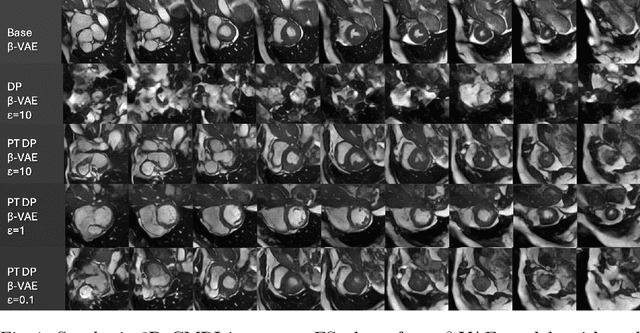
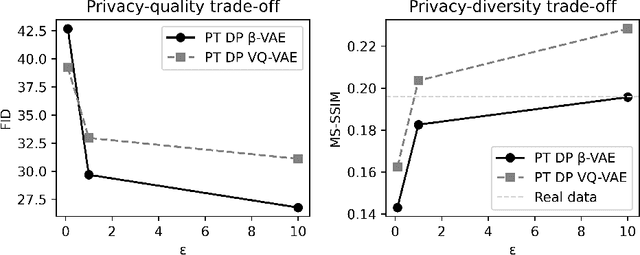

Abstract:Generally, the small size of public medical imaging datasets coupled with stringent privacy concerns, hampers the advancement of data-hungry deep learning models in medical imaging. This study addresses these challenges for 3D cardiac MRI images in the short-axis view. We propose Latent Diffusion Models that generate synthetic images conditioned on medical attributes, while ensuring patient privacy through differentially private model training. To our knowledge, this is the first work to apply and quantify differential privacy in 3D medical image generation. We pre-train our models on public data and finetune them with differential privacy on the UK Biobank dataset. Our experiments reveal that pre-training significantly improves model performance, achieving a Fr\'echet Inception Distance (FID) of 26.77 at $\epsilon=10$, compared to 92.52 for models without pre-training. Additionally, we explore the trade-off between privacy constraints and image quality, investigating how tighter privacy budgets affect output controllability and may lead to degraded performance. Our results demonstrate that proper consideration during training with differential privacy can substantially improve the quality of synthetic cardiac MRI images, but there are still notable challenges in achieving consistent medical realism.
Enhancing the Utility of Privacy-Preserving Cancer Classification using Synthetic Data
Jul 17, 2024Abstract:Deep learning holds immense promise for aiding radiologists in breast cancer detection. However, achieving optimal model performance is hampered by limitations in availability and sharing of data commonly associated to patient privacy concerns. Such concerns are further exacerbated, as traditional deep learning models can inadvertently leak sensitive training information. This work addresses these challenges exploring and quantifying the utility of privacy-preserving deep learning techniques, concretely, (i) differentially private stochastic gradient descent (DP-SGD) and (ii) fully synthetic training data generated by our proposed malignancy-conditioned generative adversarial network. We assess these methods via downstream malignancy classification of mammography masses using a transformer model. Our experimental results depict that synthetic data augmentation can improve privacy-utility tradeoffs in differentially private model training. Further, model pretraining on synthetic data achieves remarkable performance, which can be further increased with DP-SGD fine-tuning across all privacy guarantees. With this first in-depth exploration of privacy-preserving deep learning in breast imaging, we address current and emerging clinical privacy requirements and pave the way towards the adoption of private high-utility deep diagnostic models. Our reproducible codebase is publicly available at https://github.com/RichardObi/mammo_dp.
Machine Unlearning for Medical Imaging
Jul 10, 2024

Abstract:Machine unlearning is the process of removing the impact of a particular set of training samples from a pretrained model. It aims to fulfill the "right to be forgotten", which grants the individuals such as patients the right to reconsider their contribution in models including medical imaging models. In this study, we evaluate the effectiveness (performance) and computational efficiency of different unlearning algorithms in medical imaging domain. Our evaluations demonstrate that the considered unlearning algorithms perform well on the retain set (samples whose influence on the model is allowed to be retained) and forget set (samples whose contribution to the model should be eliminated), and show no bias against male or female samples. They, however, adversely impact the generalization of the model, especially for larger forget set sizes. Moreover, they might be biased against easy or hard samples, and need additional computational overhead for hyper-parameter tuning. In conclusion, machine unlearning seems promising for medical imaging, but the existing unlearning algorithms still needs further improvements to become more practical for medical applications.
Attack-Aware Noise Calibration for Differential Privacy
Jul 02, 2024Abstract:Differential privacy (DP) is a widely used approach for mitigating privacy risks when training machine learning models on sensitive data. DP mechanisms add noise during training to limit the risk of information leakage. The scale of the added noise is critical, as it determines the trade-off between privacy and utility. The standard practice is to select the noise scale in terms of a privacy budget parameter $\epsilon$. This parameter is in turn interpreted in terms of operational attack risk, such as accuracy, or sensitivity and specificity of inference attacks against the privacy of the data. We demonstrate that this two-step procedure of first calibrating the noise scale to a privacy budget $\epsilon$, and then translating $\epsilon$ to attack risk leads to overly conservative risk assessments and unnecessarily low utility. We propose methods to directly calibrate the noise scale to a desired attack risk level, bypassing the intermediate step of choosing $\epsilon$. For a target attack risk, our approach significantly decreases noise scale, leading to increased utility at the same level of privacy. We empirically demonstrate that calibrating noise to attack sensitivity/specificity, rather than $\epsilon$, when training privacy-preserving ML models substantially improves model accuracy for the same risk level. Our work provides a principled and practical way to improve the utility of privacy-preserving ML without compromising on privacy.
 Add to Chrome
Add to Chrome Add to Firefox
Add to Firefox Add to Edge
Add to Edge